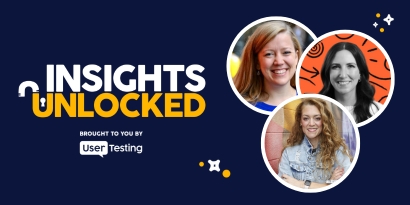
Episode 140 | October 14, 2024
How Signet Jewelers leverages customer insights across omni-channel experiences
Discover how Signet Jewelers uses customer insights to build trust and confidence across its brands, enhancing both in-store and online experiences.
How Signet Jewelers leverages customer insights across omni-channel experiences
In the fast-paced world of UX research, it’s not always about having all the answers—sometimes, it’s about being open to possibilities. "Sometimes, the next 'yes' opens a door you didn’t even know existed," said Shannon Graf, Director of Design Research at Signet Jewelers.
Shannon talked with Cornelia Klimek, Group Product Manager of Core Experience at UserTesting, in a recent interview for the Insights Unlocked podcast.
Embracing the "Next Yes"
One of the most powerful themes Shannon shared in the episode was how saying “yes” to new opportunities helped her overcome self-doubt and achieve an unexpected milestone. She recounted how the pandemic led her to write her first nonfiction book, It's Nothing but Pavement: Shedding the Should When the Path before You is Not Always the Path You Choose. Initially, she resisted the idea, unsure if she had a story worth telling. "My immediate response was no," she admitted, reflecting on her publisher’s suggestion to write about her own story. But by embracing the possibility, she found herself on a new path.
"I encourage anybody listening: What can that yes lead you to?" — Shannon Graf
In her UX research career, this mindset serves her well. Graf emphasized how being open to opportunities has allowed her and her team to adapt to user needs and uncover new insights. “I encourage anybody listening: What can that yes lead you to?” Graf said, inviting listeners to consider how saying yes could push their boundaries in unexpected ways.
UX Research: Leading with Insights
Shannon’s philosophy of openness extends into her work at Signet Jewelers, the world’s largest retailer of diamond jewelry and where consumer insights is a recognized key contributor to the company’s recent success for such iconic brands as Kay, Zales, and Jared.
Leading the UX research team, Shannon and her team focus on building personalized digital experiences that enhance customer engagement. She explains that at Signet, there is strong top-down support for research.
“One of the most refreshing aspects of joining Signet is the strong buy-in for research,” Shannon said. “If you lead with insights, you actually save time, resources, and energy on the back end. I didn’t have to convince anyone of that here—it was already understood.”
The combination of data-driven research and openness to new methodologies helps Signet continually improve.
"If you lead with insights, you're actually saving time, resources, and energy on the back end." — Shannon Graf
Using the Kano Model to prioritize UX features for maximum impact
One recent example was employing the Kano Model to help understand customer expectations when they were in the stores.
“We used the Kano method to help us understand which features were desirable, must-haves, or nice-to-haves for our in-store jewelry consultants,” Shannon said.
A Kano Study is a user research technique used to prioritize features based on customer satisfaction and their perceived value. The method helps distinguish between essential features, those that delight users, and features that are merely nice-to-have. The Kano model segments features into five categories: basic needs, performance needs, excitement features, indifferent features, and reverse features (those that some users dislike). By understanding how different features impact user satisfaction, product teams can make better decisions about which features to develop or improve.
In the context of UX research, the Kano model is particularly useful when teams need to balance user desires with development resources. It helps prioritize features that will have the most significant impact on user satisfaction, guiding both product and UX teams in focusing on what really matters to users. This method is often used in the early stages of product development to ensure that teams focus on the right set of features.
Shannon Graf's team at Signet Jewelers applied the Kano method in their in-store research to assess how new technologies, like AI, could enhance the customer experience. They found that while AI was expected to face resistance, but the opposite was the case.
“People are very familiar with AI now,” Shannon said. “And many actually expect it to support their shopping journey.”
The study helped prioritize which features would be most beneficial in improving the in-store experience.
For more detailed guidance on UX testing methods, including Kano studies, you can check UserTesting's resources, such as the blog post 5 questions to help prioritize your research.
Personalization and building trust
Another key area Shannon discussed was the importance of personalization in the customer journey. Signet focuses heavily on ensuring customers feel confident in their purchases, particularly since jewelry is often a significant financial and emotional investment. “If there's a glitch in that process, it can be a dip in confidence,” Shannon explained. Her team works diligently to ensure the digital experience is seamless, helping customers feel supported as they navigate the purchase journey.
Through research, Shannon's team discovered that many customers were unaware of the depth of customization options available at Signet’s brands. By amplifying this feature, they’ve seen a positive shift in customer engagement. Whether online or in-store, personalization and trust are key components of the experience they strive to deliver.
"Jewelry is an investment... how do you instill confidence through a digital experience?" — Shannon Graf
Ending with a "Yes"
Shannon Graf’s journey is a reminder that growth—whether personal or professional—often comes from saying yes to new possibilities. Her work at Signet Jewelers shows how UX research, when done with an open mind, can transform both customer experiences and business outcomes.
As Graf eloquently put it, “Just consider what that next yes could bring into your life.”
"Just consider what that next yes could bring into your life." — Shannon Graf
Episode links:
- How to Create Impactful UX Audits with Customer Insights
This page dives into the importance of leveraging customer feedback for UX audits, a key concept Shannon mentioned about using insights to drive decision-making at Signet.
https://www.usertesting.com/blog/ux-audits-with-customer-insights - How to Improve Your User Experience
This guide focuses on enhancing user experience through responsive design, personalization, and usability testing—all themes Shannon highlighted in her discussion on customer engagement and confidence in digital experiences.
https://www.usertesting.com/blog/how-to-improve-your-user-experience - What is digital personalization
This glossary entry explores digital personalization, a critical element Shannon talked about when describing how Signet tailors experiences to meet customer needs and builds trust in their jewelry purchasing journey. - A guide to digital customer experience strategy
This guide covers various strategies to improve digital customer experiences, including personalization, mobile optimization, and gathering user feedback—all areas Shannon’s team at Signet focuses on to create seamless customer journeys. - Signet Jewelers website
- Cornelia Klimek: Host of the episode, Group Product Manager at UserTesting, on LinkedIn.
- Nothing but Pavement: Shedding the Should When the Path before You is Not Always the Path You Choose by Shannon Graf
- Instagram: @ShannonGrafCreative









